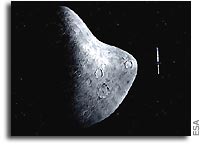Two asteroid fly-bys for Rosetta

Today the Rosetta Science Working Team has made the final selection of the
asteroids that Rosetta will observe at close quarters during its journey
to Comet 67P/Churyumov-Gerasimenko. Steins and Lutetia lie in the asteroid
belt between the orbits of Mars and Jupiter.
Rosetta’s scientific goals always included the possibility of studying one
or more asteroids from close range. However, only after Rosetta’s launch
and its insertion into interplanetary orbit could the ESA mission managers
assess how much fuel was actually available for fly-bys. Information from
the European Space Operations Centre (ESOC) in Germany enabled Rosetta’s
Science Working Team to select a pair of asteroids of high scientific
interest, well within the fuel budget.
The selection of these two excellent targets was made possible by the high
accuracy with which the Ariane 5 delivered the spacecraft into its orbit.
This of course leaves sufficient fuel for the core part of the mission,
orbiting Comet 67P/Churyumov-Gerasimenko for 17 months when Rosetta
reaches its target in 2014.
Asteroids are primitive building blocks of the Solar System, left over
from the time of its formation about 4600 million years ago. Only a few
asteroids have so far been observed from nearby. They are very different
in shape and size, ranging from a few kilometres to over 100 kilometres
across, and in their composition.
The targets selected for Rosetta, Steins and Lutetia, have rather
different properties. Steins is relatively small, with a diameter of a few
kilometres, and will be visited by Rosetta on 5 September 2008 at a
distance of just over 1700 kilometres. This encounter will take place at a
relatively low speed of about 9 kilometres per second during Rosetta’s
first excursion into the asteroid belt.
Lutetia is a much bigger object, about 100 kilometres in diameter. Rosetta
will pass within about 3000 kilometres on 10 July 2010 at a speed of 15
kilometres per second. This will be during Rosetta’s second passage
through the asteroid belt.
Rosetta will obtain spectacular images as it flies by these primordial
rocks. Its onboard instruments will provide information on the mass and
density of the asteroids, thus telling us more about their composition,
and will also measure their subsurface temperature and look for gas and
dust around them.
Rosetta began its journey just over a week ago, on 2 March, and is well on
its way. Commissioning of its instruments has already started and is
proceeding according to plan.
"Comets and asteroids are the building blocks of our Earth and the other
planets in the Solar System. Rosetta will conduct the most thorough
analysis so far of three of these objects," said Prof. David Southwood,
Director of ESA’s Science Programme. "Rosetta will face lots of challenges
during its 12-year journey, but the scientific insights that we will gain
into the origin of the Solar System and, possibly, of life are more than
rewarding."
For further information, please contact :
ESA Media Relations Division
Tel: +33(0)1.53.69.7155
Fax: +33(0)1.53.69.7690









